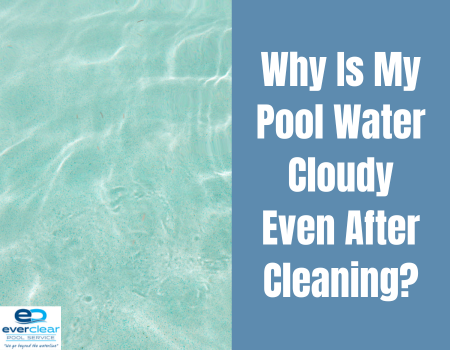There’s nothing more frustrating for a pool owner than spending time cleaning your pool, skimming debris, vacuuming the floor, and adjusting chemicals — only to look down and see cloudy water staring back at you. If your pool water still looks hazy even after a thorough cleaning, you’re not alone. Cloudy water is one of the most common pool maintenance issues, and it can be surprisingly persistent if the root cause isn’t properly addressed.
So, what’s causing your cloudy pool water, and how can you fix it for good? Let’s break it down.
 What Causes Cloudy Pool Water?
What Causes Cloudy Pool Water?
Cloudy water occurs when fine particles, contaminants, or imbalanced chemicals are suspended in the water, scattering light and creating a dull, hazy appearance. Even if your pool looks physically clean — with no visible debris or dirt — several factors might still be making your water appear murky.
Here are the most common culprits:
1. Poor Water Chemistry
The most frequent reason for cloudy water is unbalanced pool chemistry. Even if you’ve cleaned your pool, if the chemical levels are off, your water can turn cloudy.
- Low Free Chlorine Levels:
Chlorine kills bacteria and sanitizes the water. If your chlorine is too low, contaminants can accumulate, leading to cloudiness. - High pH or Alkalinity:
High pH (above 7.8) or total alkalinity can reduce chlorine’s effectiveness, allowing organic material and particles to remain in the water. - High Calcium Hardness:
In areas with hard water (like Arizona, Texas, and much of the southwestern U.S.), high calcium levels can cause cloudy water, especially when combined with high pH and heat.
2. Poor Filtration or Circulation
Your pool filter is the first line of defense against particles that cloud the water. If your filter isn’t running long enough or isn’t working properly, it won’t effectively clear out contaminants.
- Clogged or Dirty Filter:
A dirty cartridge, sand, or DE (diatomaceous earth) filter will struggle to trap fine particles, leaving them suspended in the water. - Inadequate Filtration Time:
In hot weather or after heavy pool use, your pump may need to run longer. Most pools need at least 8–12 hours of circulation daily in summer months. - Poor Water Circulation:
Dead spots in your pool — like behind ladders, corners, or steps — can trap particles. Ensure your return jets are properly positioned for optimal water movement.
3. Environmental Contaminants
Even with regular skimming and vacuuming, certain environmental factors can quickly cloud your pool water:
- Pollen, dust, and debris carried by wind or storms
- Sunscreen, body oils, and sweat from swimmers
- Algae spores floating in from nearby plants or untreated water sources
These microscopic particles can accumulate faster than your filter removes them, especially if your water chemistry isn’t ideal.
4. Residual Algae or Organic Buildup
Even if you don’t see obvious green or black patches, microscopic algae or organic debris can linger in your water after cleaning. Dead algae particles are notorious for making pool water appear cloudy.
If your chlorine has recently dropped too low or your pool was shocked after an algae bloom, you might need extra filtration, flocculant, or clarifier treatments to clear out the remaining particles.
Fix and Prevention
If your pool water’s still cloudy after cleaning, follow these steps:
- Test and Balance Water Chemistry:
Check your free chlorine, pH, total alkalinity, and calcium hardness levels. Adjust them to recommended ranges: - Free chlorine: 1–3 ppm
- pH: 4–7.6
- Total alkalinity: 80–120 ppm
- Calcium hardness: 200–400 ppm
- Run the Pump Longer:
Increase your pump’s runtime to at least 10–12 hours daily during the summer or after heavy use. - Clean or Backwash the Filter:
Remove and clean cartridge filters or backwash sand/DE filters. Replace filter media if it’s old or ineffective. - Use a Pool Clarifier or Flocculant:
A clarifier binds tiny particles into larger clumps your filter can trap. A flocculant sinks debris to the bottom for easy vacuuming. - Shock the Pool (If Needed):
If chlorine levels are low or after heavy use, shock your pool to quickly raise sanitizer levels and kill lingering contaminants. - Brush and Vacuum Thoroughly:
Even after skimming, manually brush pool walls and steps to dislodge particles hiding in dead spots.
A clean-looking pool isn’t always a clear pool. Cloudy pool water, even after cleaning, usually signals an issue with water balance, filtration, or hidden contaminants. The key to keeping your pool sparkling clear is consistent water testing, proper chemical management, and ensuring your filter system is running efficiently.
With the right care and attention from a professional pool service, you can enjoy crystal-clear, refreshing pool water all season long.
